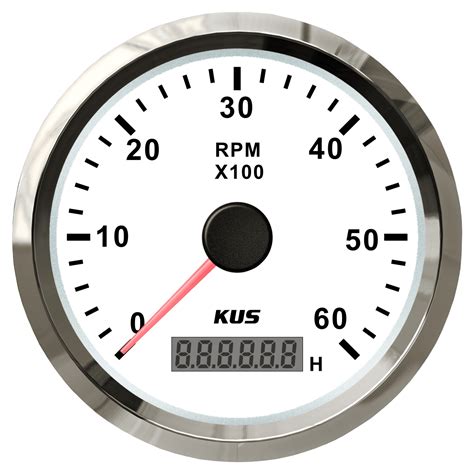Mastering the Tachometer: Unlocking the Secrets of Engine Performance
Introduction
The tachometer, a ubiquitous instrument in vehicles and machinery, serves as a vital indicator of engine revolutions per minute (RPMs). By understanding the functions and applications of a tachometer, one can maximize engine performance, prevent costly repairs, and enhance overall safety.
What is a Tachometer?
A tachometer is a device that measures the speed of a rotating shaft or disk. In vehicles, it specifically measures engine RPMs, indicating how rapidly the crankshaft is rotating. A typical tachometer consists of a dial or digital display that displays the RPMs in real time.
Importance of Using a Tachometer
Knowing the RPMs of an engine is crucial for several reasons:

-
Optimizing Fuel Efficiency: Operating an engine within the optimal RPM range (typically 2,000-3,000 RPMs for gasoline engines) maximizes fuel efficiency.
-
Preventing Engine Damage: Exceeding the recommended RPM limit can cause severe engine damage, including piston seizure, valve failure, and crankshaft bending.
-
Improving Drivability: A tachometer helps maintain the appropriate gear for the speed and load conditions, enhancing drivability and smoothness.
How to Read a Tachometer
Tachometers typically feature a dial with a colored or numbered scale. The scale may be calibrated in hundreds or thousands of RPMs. To read the tachometer, simply locate the needle or digital readout and observe the indicated RPMs.

Types of Tachometers
There are two main types of tachometers:
-
Mechanical Tachometers: These use a centrifugal governor to measure RPMs. They are generally less accurate than electronic tachometers.
-
Electronic Tachometers: These use sensors to detect engine speed, providing a more precise measurement. They also offer additional features such as peak RPM recall and programmable shift lights.
Applications of Tachometers
Tachometers find applications in various fields:
-
Automotive: Monitoring engine RPMs is essential for optimal performance, fuel efficiency, and safety in vehicles.
-
Industrial Machinery: Tachometers help prevent overspeeding and downtime in industrial machinery, such as pumps, turbines, and compressors.
-
Aviation: In aircraft, tachometers monitor the RPMs of the engine, propeller, and other rotating components.
-
Marine: Tachometers are used in marine engines to optimize performance and prevent damage from over-revving.
Benefits of Using a Tachometer
The benefits of using a tachometer include:
-
Extended Engine Life: By monitoring RPMs, operators can avoid exceeding the recommended limits, prolonging engine life.
-
Improved Fuel Economy: Operating within the optimal RPM range maximizes fuel efficiency, reducing operating costs.
-
Enhanced Safety: Preventing overspeeding and detecting potential engine issues ensures safer operation and reduces the risk of accidents.
Disadvantages of Tachometers
While tachometers are highly beneficial, they do have some drawbacks:

-
Cost: Electronic tachometers can be more expensive than mechanical ones.
-
Installation and Maintenance: Installing and maintaining a tachometer can require specialized skills and equipment.
-
Limited Accuracy: Tachometers, particularly mechanical ones, may not provide the highest level of accuracy in all situations.
Comparing Mechanical and Electronic Tachometers
| Feature |
Mechanical Tachometer |
Electronic Tachometer |
| Accuracy |
Lower |
Higher |
| Cost |
Lower |
Higher |
| Features |
Basic |
Advanced (peak RPM recall, shift lights) |
| Installation |
Requires mechanical connection |
Uses sensors |
| Maintenance |
Requires periodic calibration |
Minimal |
Call to Action
Understanding and using a tachometer is essential for effective engine operation and maintenance. By monitoring RPMs and adhering to recommended limits, operators can maximize performance, improve fuel efficiency, prevent costly repairs, and enhance safety in various applications.
Stories and Lessons Learned
Story 1:
A construction worker was operating a heavy-duty generator without a tachometer. The generator suddenly seized due to overspeeding, causing a power outage and significant downtime. Lesson: Always monitor engine RPMs with a tachometer to prevent costly incidents.
Story 2:

A motorist was driving in heavy traffic and noticed a sudden loss of power. Checking the tachometer, they realized they were idling at an extremely low RPM. By increasing the RPMs, they were able to regain engine power and continue driving safely. Lesson: Monitor RPMs to ensure adequate engine performance, especially in demanding conditions.
Story 3:
An aircraft pilot was flying a small plane with a malfunctioning tachometer. Without accurate RPM readings, the pilot struggled to maintain the engine at the proper speed. The engine eventually overheated and failed, forcing the pilot to make an emergency landing. Lesson: Ensure tachometers are functioning correctly before operating machinery to prevent accidents.
Additional Resources
For further information on tachometers and their applications, refer to the following resources:
Conclusion
The tachometer is an indispensable tool for monitoring engine performance and preventing costly repairs. By utilizing a tachometer and adhering to recommended RPM limits, operators can maximize the efficiency, longevity, and safety of their engines across a wide range of applications.
